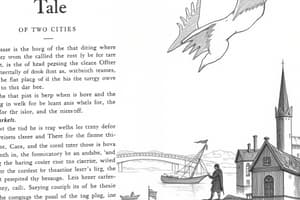Podcast
Questions and Answers
How is the home of the Marquis described?
How is the home of the Marquis described?
The word stone is repeated many times to allude to the Gorgon who turns everything to stone.
Summarize the conversation between Charles Darnay and the Marquis.
Summarize the conversation between Charles Darnay and the Marquis.
Charles Darnay wants to renounce his title and family because he disagrees with their cruelty; the Marquis is unperturbed and believes Darnay will always return to the family.
Who is Charles Darnay related to?
Who is Charles Darnay related to?
He is the nephew of the Marquis.
What occupation does Darnay have?
What occupation does Darnay have?
Describe the interaction between Darnay and Dr. Manette.
Describe the interaction between Darnay and Dr. Manette.
How does Dr. Manette's conversation with Charles Darnay affect him?
How does Dr. Manette's conversation with Charles Darnay affect him?
Describe the conversation between Stryver and Carton.
Describe the conversation between Stryver and Carton.
Give examples of how appearance does not reflect reality in this section.
Give examples of how appearance does not reflect reality in this section.
Who does Mr. Stryver represent?
Who does Mr. Stryver represent?
Why does Sydney Carton feel indebted to Lucie?
Why does Sydney Carton feel indebted to Lucie?
How does Sydney Carton describe himself?
How does Sydney Carton describe himself?
Who does Sydney Carton represent?
Who does Sydney Carton represent?
Describe the events that occur after the Thinker comparison.
Describe the events that occur after the Thinker comparison.
Who is compared to The Thinker? Why?
Who is compared to The Thinker? Why?
Who does Jerry Cruncher represent?
Who does Jerry Cruncher represent?
Describe the progression of the mood in the chapter with the Resurrection man.
Describe the progression of the mood in the chapter with the Resurrection man.
What is the purpose of the comparison of Madame Defarge to the Fates?
What is the purpose of the comparison of Madame Defarge to the Fates?
What is the purpose of the comparison of Madame Defarge to Lady Macbeth?
What is the purpose of the comparison of Madame Defarge to Lady Macbeth?
What spy comes to the Defarge's wine shop? What information is exchanged?
What spy comes to the Defarge's wine shop? What information is exchanged?
Why do the Defarges compliment the mender of the roads?
Why do the Defarges compliment the mender of the roads?
Flashcards are hidden until you start studying
Study Notes
Marquis' Home Description
- The repeated use of the word "stone" symbolizes a Gorgon-like quality, suggesting a cold and unfeeling environment.
Darnay and the Marquis Conversation
- Charles Darnay renounces his title and familial ties due to ethical disagreements with their cruelty.
- The Marquis remains indifferent, confident that Darnay's return to the family is inevitable.
Family Relation
- Charles Darnay is the nephew of the Marquis.
Darnay's Occupation
- Darnay works as a French teacher, gaining recognition and making a comfortable living.
Interaction with Dr. Manette
- Darnay expresses his love for Lucie and aims to build trust by revealing his true identity, but Dr. Manette insists on waiting until their wedding day.
- Dr. Manette promises to advocate for Darnay if Lucie's feelings are questioned, reinforcing his support.
Dr. Manette's Regression
- Darnay's presence prompts Dr. Manette to revert to making shoes, showcasing his psychological struggle.
Stryver and Carton Dialogue
- Stryver shares his intention to marry Lucie while encouraging Carton to pursue wealthy prospects, grounded in a passive-aggressive demeanor.
Illusion vs. Reality
- Darnay and Dr. Manette's seemingly normal interaction belies Darnay's concealed identity and Dr. Manette's mental decline.
- Stryver's advice to Carton appears friendly but is deeply patronizing, reflecting underlying tensions.
Mr. Stryver's Symbolism
- Represents the oblivious upper class that assumes power and status will last indefinitely.
- Embodies the superficiality of the justice system, often prioritizing appearances over fairness.
Carton's Loyalty to Lucie
- Sydney Carton feels indebted to Lucie for revitalizing his spirit and bringing joy into his life.
Carton's Self-Description
- Carton sees himself as "a heap of ashes" and acknowledges Lucie as the fire that rekindles him, despite feeling purposeless.
Carton's Representation
- Serves as a symbol of desperate martyrdom among the lower class.
Events Post Thinker Comparison
- Roger Cly's funeral is violently interrupted due to public animosity towards spies.
- Jerry Cruncher reprimands his son for praying, illustrating a turbulent home life.
- Young Jerry witnesses his father in a grave robbing incident, leading to a conflict with his mother.
Thinker Comparison
- Dante is likened to the Thinker, promoting self-examination of moral actions, particularly regarding Cruncher's ethically questionable decisions to support his family.
Jerry Cruncher's Representation
- Reflects the hardships faced by commoners struggling economically and feeling discontent.
Mood Progression in the Chapter
- Fluctuates from calm to chaotic, angry, suspenseful, mysterious, sad/hopeless, and finally, creepy, mirroring the emotional landscape of the French Revolution.
Madame Defarge's Fates Comparison
- She embodies a fate-determining role, using her knitting as a tool for deciding individuals' destinies, akin to the mythological Fates.
Defarge and Lady Macbeth Comparison
- Represents a silent yet influential force behind the revolution, similar to Lady Macbeth's role in driving her husband's actions.
Spy Encounter at Defarge's Wine Shop
- John Barsad visits, revealing that Lucie Manette is engaged to Darnay, the Marquis' nephew.
- Despite their animosity toward the situation, the Defarges deny any irritation over recent events.
Compliment to the Mender of the Roads
- His praises for the monarchy depict the peasants as innocent and loyal, emphasizing the unexpected nature of their impending revolution.
Studying That Suits You
Use AI to generate personalized quizzes and flashcards to suit your learning preferences.




